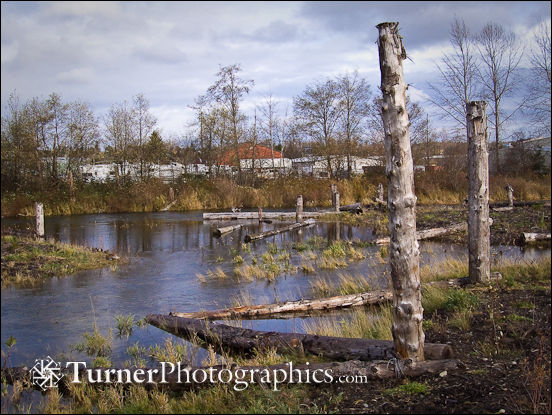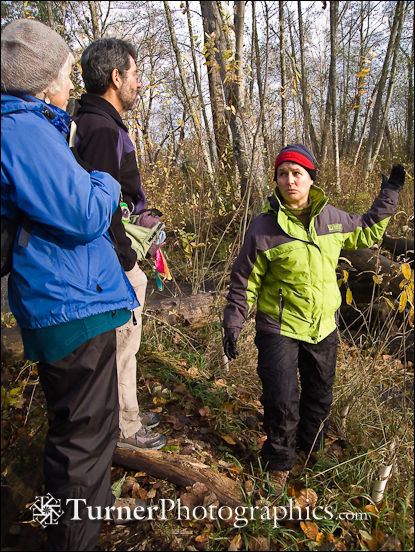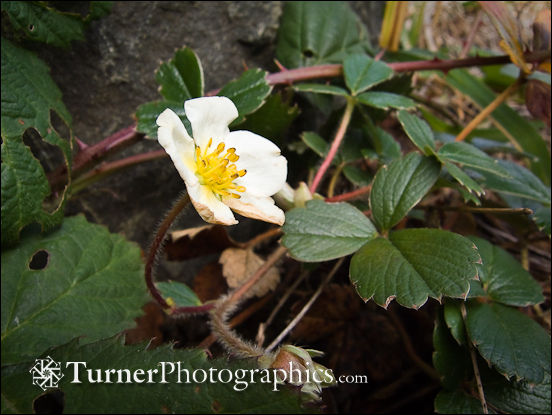Whatcom Creek Restoration

A little over ten years ago this stretch of Whatcom Creek through Bellingham burned when gasoline spilled from the Olympic Pipeline in Whatcom Falls Park a couple of miles upstream. It was a major tragedy in which three young people died and beautiful shady woodland habitat along the creek was destroyed. But this section of creek didn’t have much going for it at that time. It was channelized with rock riprap and a weedy field of fill dirt came up to the edge of the blackberry-choked creek.
In 2008 Bellingham initiated a major stream improvement project here and constructed a new trail along the south side of the creek. Designed to reduce flooding on nearby Iowa Street and provide backwater spawning habitat for salmon, 30,000 cubic yards of fill dirt were removed. The slope was graded, native trees and shrubs were planted, and snags were pounded into the ground.
Today, a group of us from the Koma Kulshan chapter of the Washington Native Plant Society toured the area to see the results of the restoration as well as an older planting upstream.
 Vikki Jackson was our tour leader. She’s seen here explaining about an older man-made wetland pond constructed several years ago to provide wildlife habitat.
Vikki Jackson was our tour leader. She’s seen here explaining about an older man-made wetland pond constructed several years ago to provide wildlife habitat.
We looked at what species had been planted and discussed the engineering that went into the new wetlands and spawning channels along the creek. The water was running high from our November storms, so we could easily see how engineered log jams were diverting some of the stream flow into the side channels and away from the businesses along Iowa Street on the north bank. Most of the plantings were shrubs like ninebark, red-osier dogwood, hardhack, and snowberry, with some salal and kinnickinick closer to the trail. There were a few maples and a fair number of conifers like Douglas-fir and western red cedar. What we found striking in their absence were red alders and black cottonwoods. Both are early successional trees and alders in particular improve the soil by adding nitrogen.
Overall, we were impressed with the work at Red Tail Reach and look forward to watching what grows, what dies, and how the environment changes in the coming years.

Upstream of the Fraser Street connector trail the restoration has been in place for about nine years. The shrub layer is maturing nicely and the conifers are about 15 feet tall. We mostly agreed that jump starting the mature conifer forest along the creek was a good plan here. There is no nearby seed source, so it would have taken a long time for any Douglas-firs or cedars to get started. Not all the original trees along the creek had burned and we saw a couple of clumps of large cottonwoods.
Among the trees planted were Sitka spruces and some of them had these clumps of brown foliage that Lyle is examining in the photo above. Is this damage from Spruce Needle Miner, Endothenia albolineana, or something else? Whatever caused the damage seemed to only attack new foliage. Here’s a detail:

I’m certainly not an expert in plant diseases nor insect damage. There are aphids that feed on spruces as well as some fungal diseases, but results of my limited Google search suggested that neither of these were the likely culprit because they mostly attack older foliage and this damage appears to be limited to new needles.
After I originally posted this a friend e-mailed that the brown cone-like lump is most likely a Cooley Spruce Gall, produced by Cooley spruce gall adelgids, Adelges cooleyi. The galls are unsightly on spruces, but apparently do little long-term damage to the trees. The aldegids have a complex life cycle which includes Douglas-fir as an alternate host. See Cooley Spruce Galls from Colorado State University Extension for more info.

Our outing included spying a few flowers in bloom, mostly non-native weeds. But this little beach strawberry, Fragaria chiloensis was blooming at the base of a south-facing rock protecting a storm sewer outlet channel from erosion. It was struggling to compete with invasive Himalayan blackberries that you can see around the strawberry.
Today’s photos were all made with my pocket camera, a Canon S70.
We’ve had three weeks of heavy rain, high winds, and generally typical November weather. Does the sighting of the first strawberry blooming mean that spring has arrived? You be the judge, but I’m hopeful.


Thank you for the fun summary of our trip Mark. It turned out to be a great day!
Thanks for your comments about Red Alder & Black Cottonwood, both of which perform valuable ecological services.
People often operate via their personal and cultural prejudices, to the detriment of all.
I’ve heard various derogatory comments about these two trees– from both professionals and Tree Board members of City of Woodinville!
They’ve said that they are “not valuable” and even “trash trees”!!!.
It was an energy drain to attempt to convince one city employee (a “wetland specialist”!), so volunteers just went ahead and transplanted Red Alder onto the Sammamish River.
An enlightened Woodinville Tree Board member has commented that Red Alder is known for (healing?) properties in Aryuvedic (sp?) medicine.
So, thanks to Red Alder, Cottonwood & folks who recognize intrinsic value rather than operate according to cultural ranking & prejudice!
Mark: Great blog and incredibly professional looking!! Keep up your good work.
Mark–
I enjoyed reading your blog about the Redtail Reach restoration site. It’s great to know members of the community are actively taking part in the site. I especially appreciate the comments regarding red alder and cottonwoods. Those species do have a special role in ripairian communities. The City of Bellingham has over 50 restoration sites around town. We find that the alders and cottonwoods readily sprout up in all the sites one -two years after the site was restored. In most sites we find we couldn’t keep them out if we wanted to. If you look closely at the ground at Redtail reach you will see they are already starting to come in.
Renee LaCroix
Restoration Coordinator
City of Bellingham